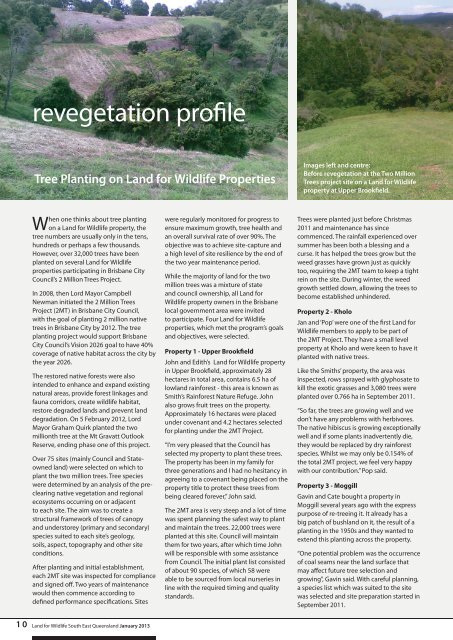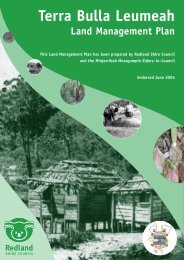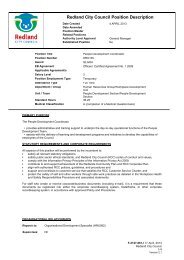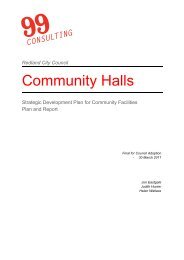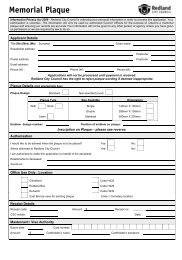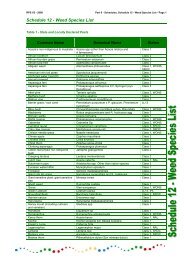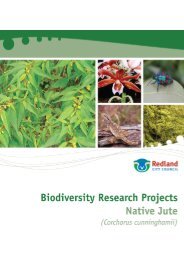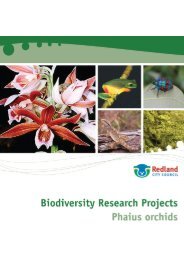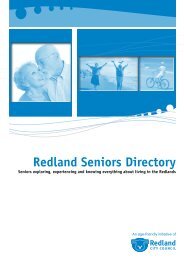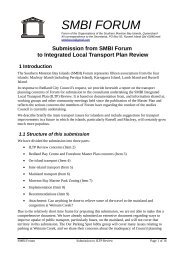Land for Wildlife Newsletter - IndigiScapes
Land for Wildlife Newsletter - IndigiScapes
Land for Wildlife Newsletter - IndigiScapes
You also want an ePaper? Increase the reach of your titles
YUMPU automatically turns print PDFs into web optimized ePapers that Google loves.
evegetation profile<br />
Tree Planting on <strong>Land</strong> <strong>for</strong> <strong>Wildlife</strong> Properties<br />
Images left and centre:<br />
Be<strong>for</strong>e revegetation at the Two Million<br />
Trees project site on a <strong>Land</strong> <strong>for</strong> <strong>Wildlife</strong><br />
property at Upper Brookfield.<br />
When one thinks about tree planting<br />
on a <strong>Land</strong> <strong>for</strong> <strong>Wildlife</strong> property, the<br />
tree numbers are usually only in the tens,<br />
hundreds or perhaps a few thousands.<br />
However, over 32,000 trees have been<br />
planted on several <strong>Land</strong> <strong>for</strong> <strong>Wildlife</strong><br />
properties participating in Brisbane City<br />
Council’s 2 Million Trees Project.<br />
In 2008, then Lord Mayor Campbell<br />
Newman initiated the 2 Million Trees<br />
Project (2MT) in Brisbane City Council,<br />
with the goal of planting 2 million native<br />
trees in Brisbane City by 2012. The tree<br />
planting project would support Brisbane<br />
City Council’s Vision 2026 goal to have 40%<br />
coverage of native habitat across the city by<br />
the year 2026.<br />
The restored native <strong>for</strong>ests were also<br />
intended to enhance and expand existing<br />
natural areas, provide <strong>for</strong>est linkages and<br />
fauna corridors, create wildlife habitat,<br />
restore degraded lands and prevent land<br />
degradation. On 5 February 2012, Lord<br />
Mayor Graham Quirk planted the two<br />
millionth tree at the Mt Gravatt Outlook<br />
Reserve, ending phase one of this project.<br />
Over 75 sites (mainly Council and Stateowned<br />
land) were selected on which to<br />
plant the two million trees. Tree species<br />
were determined by an analysis of the preclearing<br />
native vegetation and regional<br />
ecosystems occurring on or adjacent<br />
to each site. The aim was to create a<br />
structural framework of trees of canopy<br />
and understorey (primary and secondary)<br />
species suited to each site’s geology,<br />
soils, aspect, topography and other site<br />
conditions.<br />
After planting and initial establishment,<br />
each 2MT site was inspected <strong>for</strong> compliance<br />
and signed off. Two years of maintenance<br />
would then commence according to<br />
defined per<strong>for</strong>mance specifications. Sites<br />
were regularly monitored <strong>for</strong> progress to<br />
ensure maximum growth, tree health and<br />
an overall survival rate of over 90%. The<br />
objective was to achieve site-capture and<br />
a high level of site resilience by the end of<br />
the two year maintenance period.<br />
While the majority of land <strong>for</strong> the two<br />
million trees was a mixture of state<br />
and council ownership, all <strong>Land</strong> <strong>for</strong><br />
<strong>Wildlife</strong> property owners in the Brisbane<br />
local government area were invited<br />
to participate. Four <strong>Land</strong> <strong>for</strong> <strong>Wildlife</strong><br />
properties, which met the program’s goals<br />
and objectives, were selected.<br />
Property 1 - Upper Brookfield<br />
John and Edith’s <strong>Land</strong> <strong>for</strong> <strong>Wildlife</strong> property<br />
in Upper Brookfield, approximately 28<br />
hectares in total area, contains 6.5 ha of<br />
lowland rain<strong>for</strong>est - this area is known as<br />
Smith’s Rain<strong>for</strong>est Nature Refuge. John<br />
also grows fruit trees on the property.<br />
Approximately 16 hectares were placed<br />
under covenant and 4.2 hectares selected<br />
<strong>for</strong> planting under the 2MT Project.<br />
“I’m very pleased that the Council has<br />
selected my property to plant these trees.<br />
The property has been in my family <strong>for</strong><br />
three generations and I had no hesitancy in<br />
agreeing to a covenant being placed on the<br />
property title to protect these trees from<br />
being cleared <strong>for</strong>ever,” John said.<br />
The 2MT area is very steep and a lot of time<br />
was spent planning the safest way to plant<br />
and maintain the trees. 22,000 trees were<br />
planted at this site. Council will maintain<br />
them <strong>for</strong> two years, after which time John<br />
will be responsible with some assistance<br />
from Council. The initial plant list consisted<br />
of about 90 species, of which 58 were<br />
able to be sourced from local nurseries in<br />
line with the required timing and quality<br />
standards.<br />
Trees were planted just be<strong>for</strong>e Christmas<br />
2011 and maintenance has since<br />
commenced. The rainfall experienced over<br />
summer has been both a blessing and a<br />
curse. It has helped the trees grow but the<br />
weed grasses have grown just as quickly<br />
too, requiring the 2MT team to keep a tight<br />
rein on the site. During winter, the weed<br />
growth settled down, allowing the trees to<br />
become established unhindered.<br />
Property 2 - Kholo<br />
Jan and ‘Pop’ were one of the first <strong>Land</strong> <strong>for</strong><br />
<strong>Wildlife</strong> members to apply to be part of<br />
the 2MT Project. They have a small level<br />
property at Kholo and were keen to have it<br />
planted with native trees.<br />
Like the Smiths’ property, the area was<br />
inspected, rows sprayed with glyphosate to<br />
kill the exotic grasses and 3,080 trees were<br />
planted over 0.766 ha in September 2011.<br />
“So far, the trees are growing well and we<br />
don’t have any problems with herbivores.<br />
The native hibiscus is growing exceptionally<br />
well and if some plants inadvertently die,<br />
they would be replaced by dry rain<strong>for</strong>est<br />
species. Whilst we may only be 0.154% of<br />
the total 2MT project, we feel very happy<br />
with our contribution.” Pop said.<br />
Property 3 - Moggill<br />
Gavin and Cate bought a property in<br />
Moggill several years ago with the express<br />
purpose of re-treeing it. It already has a<br />
big patch of bushland on it, the result of a<br />
planting in the 1950s and they wanted to<br />
extend this planting across the property.<br />
“One potential problem was the occurrence<br />
of coal seams near the land surface that<br />
may affect future tree selection and<br />
growing”, Gavin said. With careful planning,<br />
a species list which was suited to the site<br />
was selected and site preparation started in<br />
September 2011.<br />
10<br />
<strong>Land</strong> <strong>for</strong> <strong>Wildlife</strong> South East Queensland January 2013


